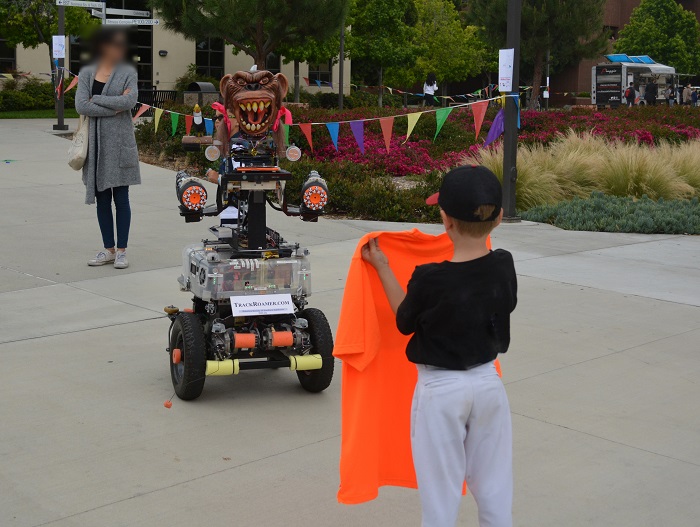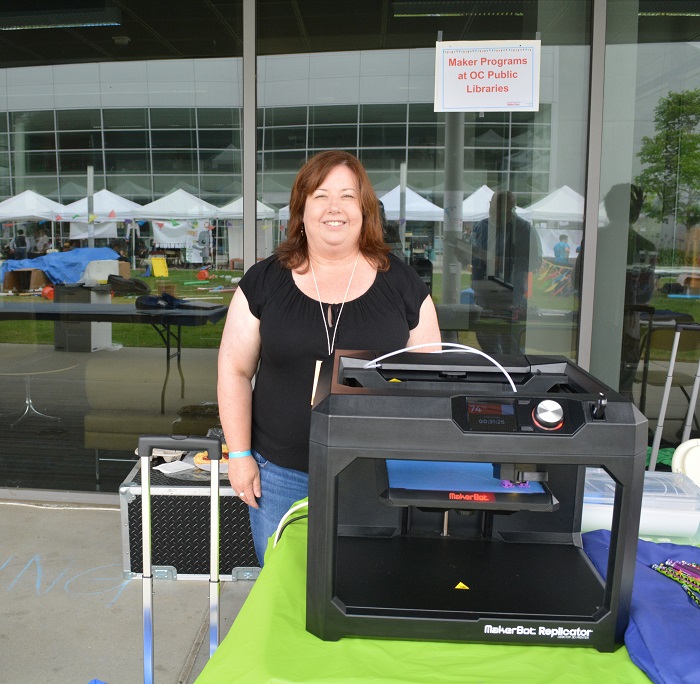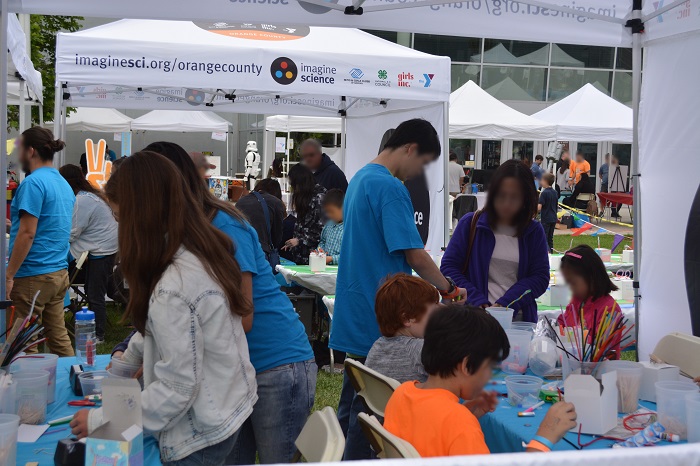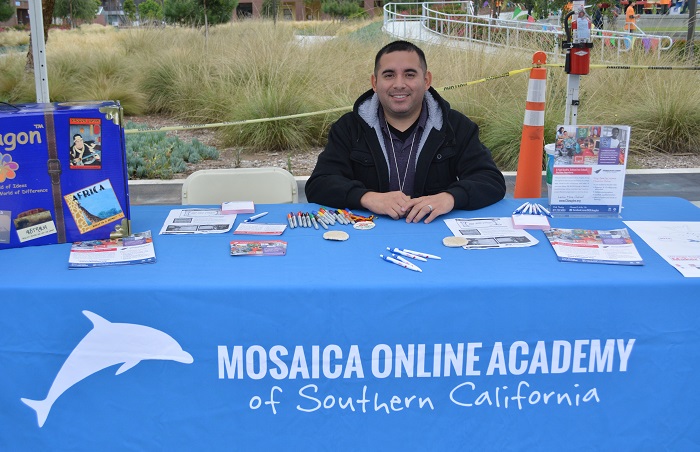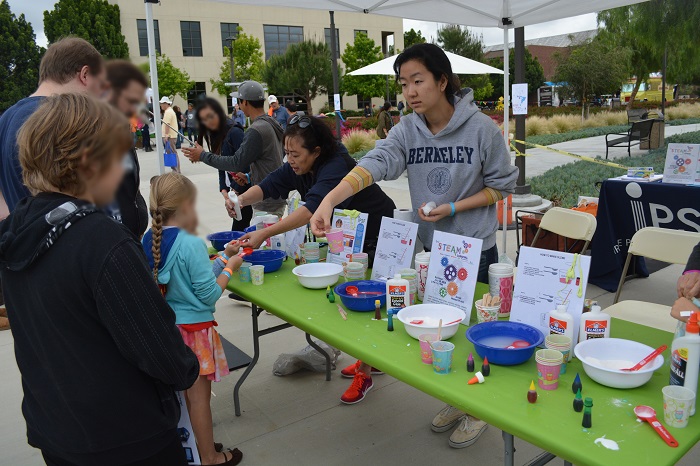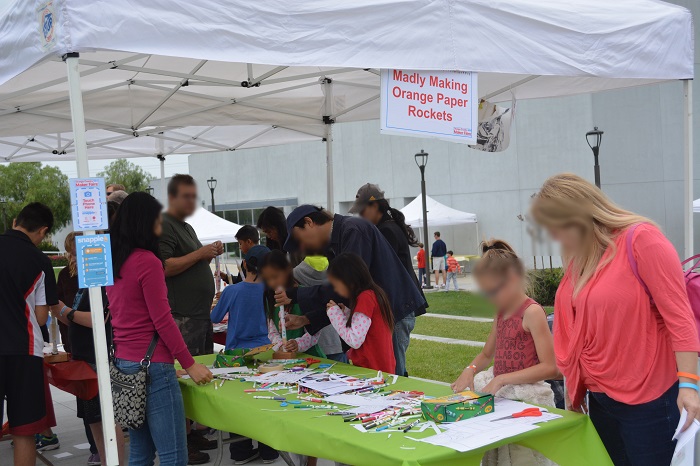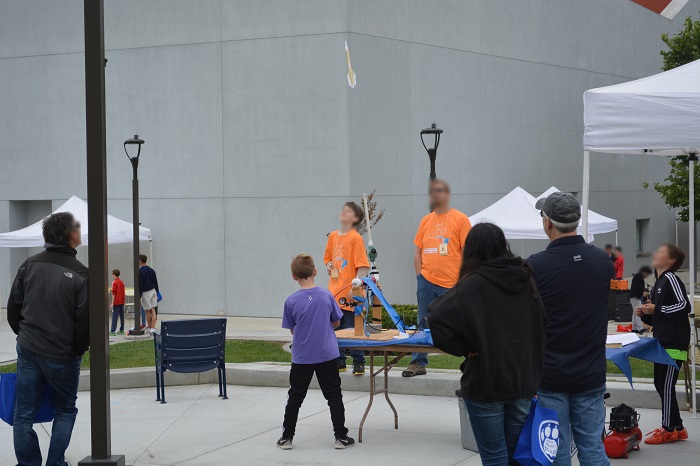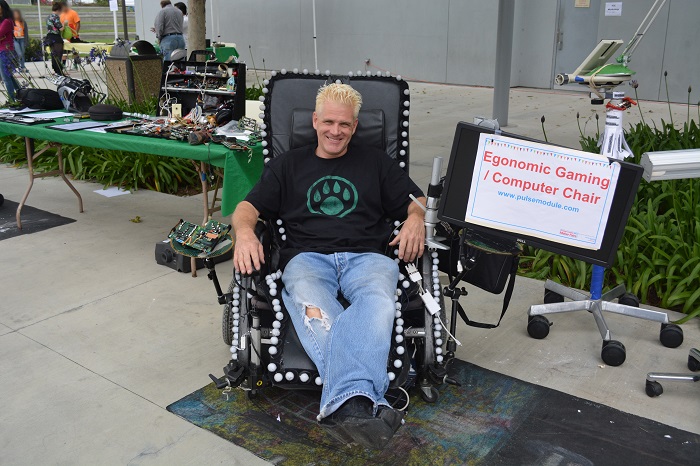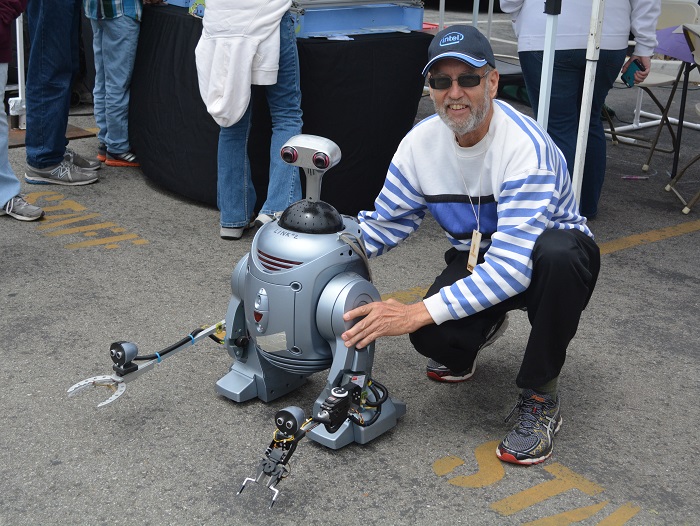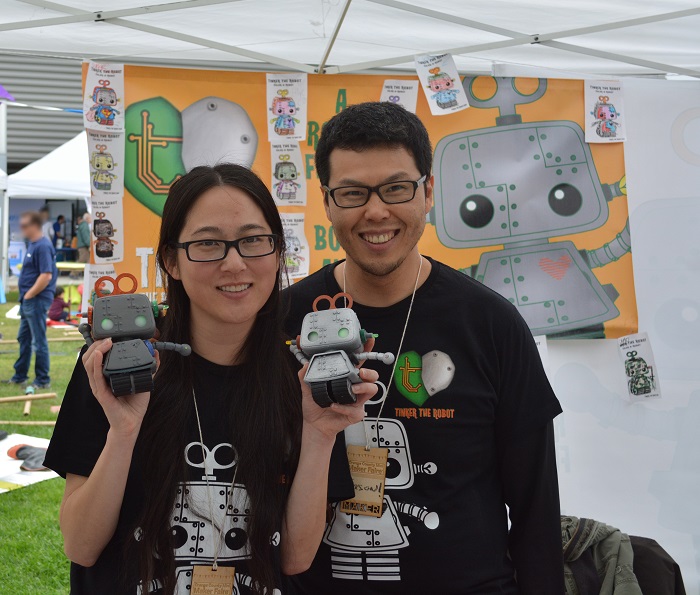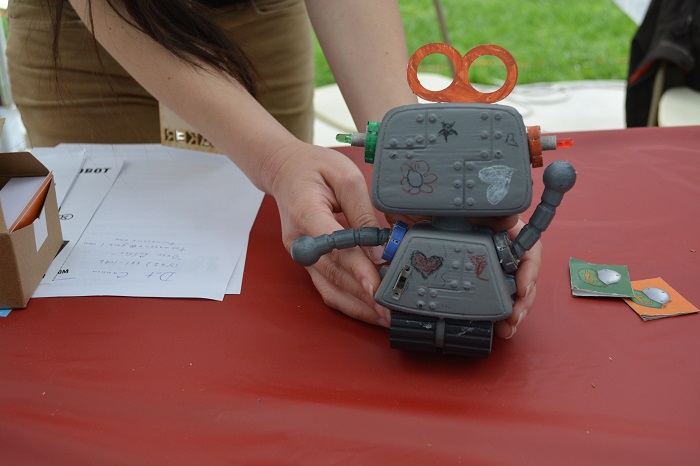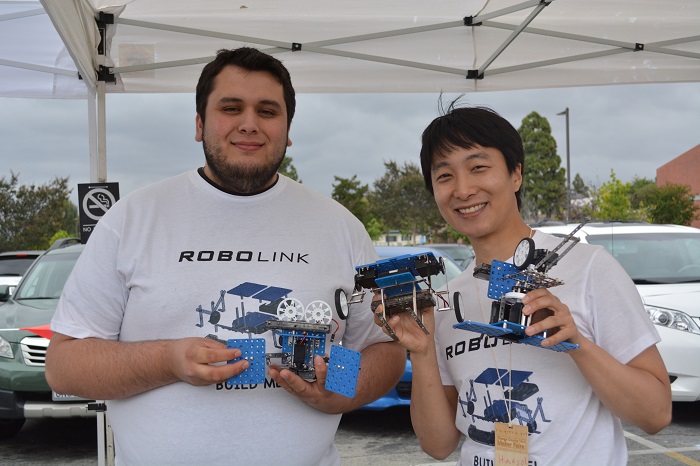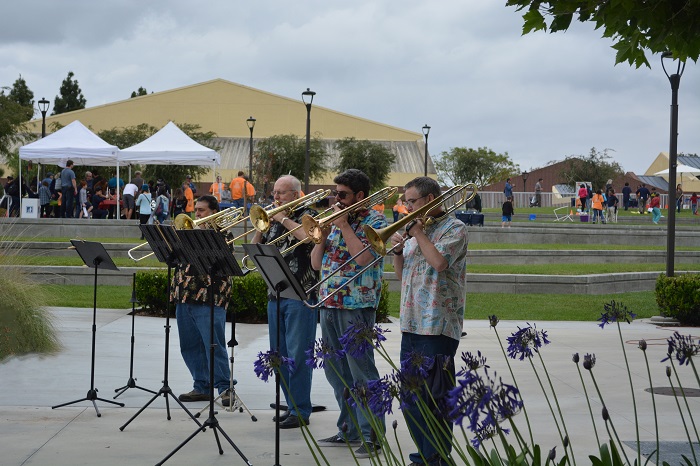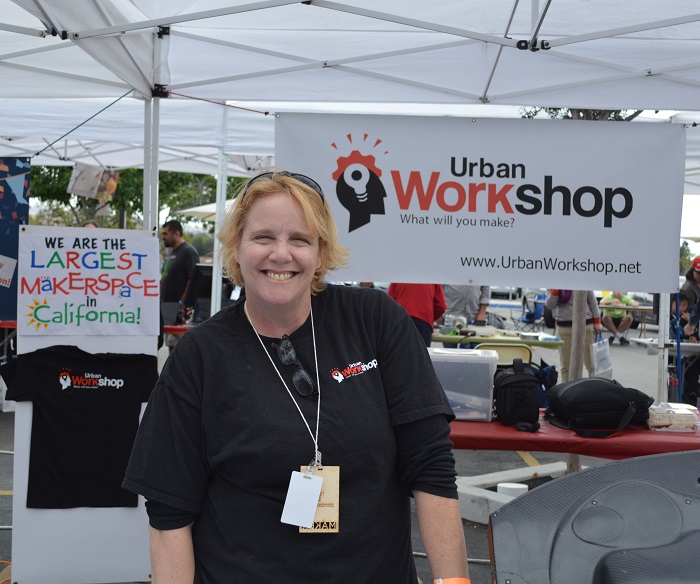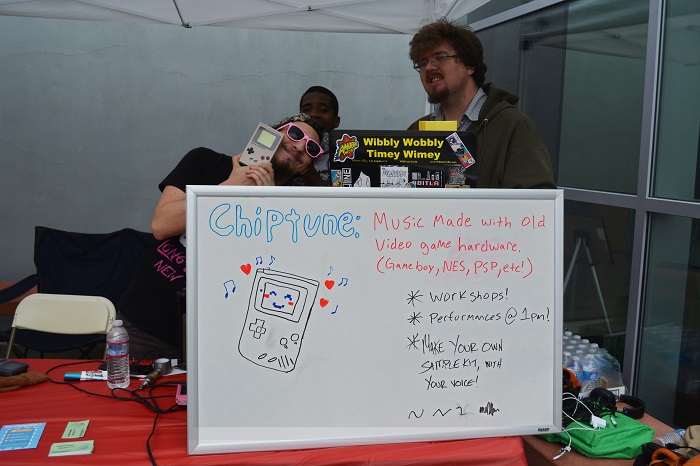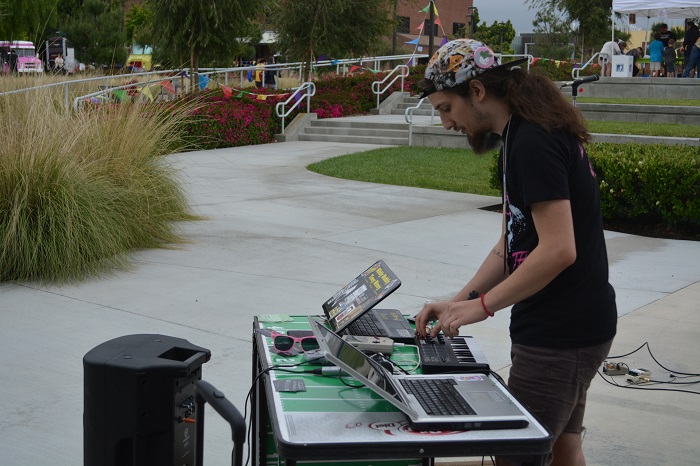by Dot Cannon 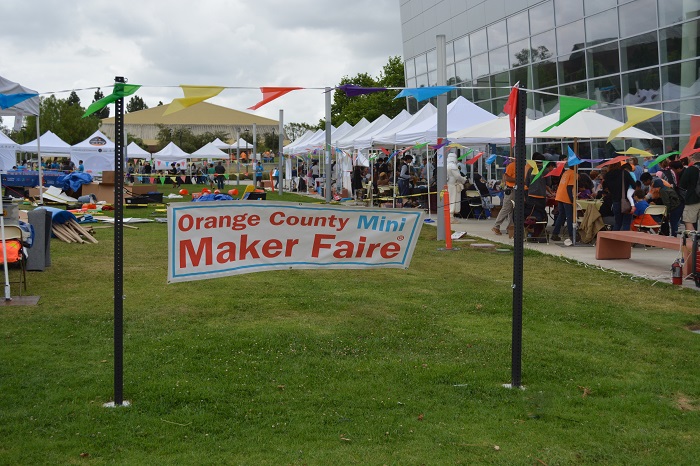
“What does this robot do?”
“It tracks people down and ‘shoots’ them, what else?”
That dialogue with Sergei Grichine, creator of this TrackRoamer robot, occurred at Saturday’s OC Mini Maker Faire, at Irvine Valley College.
And TrackRoamer did indeed track this orange shirt, “shoot” projectiles and deliver a “goodbye” at the end of its performance–much to the delight of a steady stream of visitors waiting to try him out!
Other robots–and a lot more–were waiting to be discovered.
Kimberly Banks, Teen Services Librarian for OC Public Libraries, was part of the team who’d written a grant for a new program at Orange County libraries.
“We call it the Mobile Media Lab,” she said. “It’s available for the thirty-three branches in the library system.”
The Mobile Media Lab offers free computer and tech classes at libraries throughout Orange County.
For the kickoff of the program, which started in January, the UCI Engineering Lab gave a presentation showcasing the ways they use 3D printing at UCI Medical Center, such as spinal implants. “It got everybody really excited about the potential for 3D printing,” Kimberly said.
Kimberly outlined the workshops she teaches at her branch in Garden Grove, using a 3D printing class as an example.
“We spend some time on the laptops, learning about 3D modeling,” she said. “And then, we start creating our objects and sending them to the printer.”
From June through August, the Mobile Media Lab’s schedule includes workshops in Costa Mesa, Garden Grove and Irvine. More information is available at the OCPL link.
Across the way, parents and kids were busy being creative, courtesy of a new program.
Imagine Science is a new pilot program, combining four youth-serving organizations: 4-H, YMCA of Anaheim, Boys’ and Girls’ Club of Garden Grove, and Girls Inc. of Orange County.
“Our target is to provide hands-on science education (during the summer) for youth that none of our organizations are currently serving,” said UC 4-H Camp Advisor Jason Suppes. “We’re currently getting ready for the summer. The activity here at the Maker Faire is really kind of a test…for pulling together these four organizations.”
The activity, called “Happy City”, was a community art project/circuitry and design activity, in which kids receive basic building materials, including LEDs, magnets, batteries and a plain white gift box. In the project, which was conceived by the New York Hall of Science, youth are asked to create “a structure that makes people happy”. The young creators leave their work on a large city grid, as a contribution to the “Happy City” community.
And some of the results are mind-blowing.
An eleven-year-old created this windmill–literally “thinking outside the box”!
Jason said Imagine Science had just put up their new website, and they’re looking towards the future.
“Imagine Science is currently piloted in three communities in the United States: Orange County, Omaha and Lincoln, Nebraska,” Jason said. “By 2020, the goal of Imagine Science, nationally, is to be in 800 communities, serving four million unserved youth.”
Julio Hernandez, Regional Marketing Manager at Mosaica Online Academy, explained the school’s program. “We’re a completely free K-12 online charter school, ” he said. “We cover all of Southern California.”
Julio said Mosaica provides families with their own personal computer, if needed. “We also provide them with all the curriculum they could ever need,…as well as a teacher, too.”
He said the program is based on an agreement with the teacher and is customized, depending on each individual student’s needs. “If, for example, you’re in an underperforming school, the teacher may check in and see if you’re logging into your user name, maybe…twice a day, depending on what the agreement is with the teacher. On the other hand, if your child’s an actor and they’re doing commercials, they may make the agreement with the teacher to log in more next month.”
Mosaica’s program is an intensive one, he added. “There’s always going to be a minimum set of log-ins (required). It’s really tough; it’s college prep work, so it does take a lot of attention.”
Meanwhile, it was “slime time” at the nearby Irvine Public Schools Foundation booth. Young guests received their own take-home plastic bags.
So, how do you make slime? Here’s the recipe, courtesy of Irvine Public Schools Foundation, for your Halloween-party enjoyment.
Meanwhile, this group of visitors, in an open, grassy area, may well have included some of tomorrow’s aerospace engineers.
“3-2-1!” chorused kids and “big kids” alike, just prior to the repeated launches.
Among the exhibitors were several who had just launched Kickstarter campaigns, for their projects. One of them was Pulse Keyboard designer David Hayden, creator of both a new alphabetical keyboard app for the iPad, and this device.
“This is my chill computer station/gaming chair,” he said. “I built it mainly just to be able to relax, to program, and to be able to have a screen in front of me while I code. And then it evolved into realizing that you can play video games with it, and so I added the wheels to give it the action of turning.”
David, who is the founder of Interactive Ergonomics, said the studs, on the outside of the chair, are calibration markers for video. “So, if someone wanted to stick me into a movie, it’d be quite easy.”
He also offered a resource for fellow creators, at his “Hacker Kits” site. “There’s a thing called a pulse module there, and that’ll get hackers ready to do what I’m doing,” he said.
Currently, David is also developing a one-handed keyboard app for the iPad. And he performed a community service, of sorts, that gamers will appreciate, as the Mini Maker Faire progressed…
…by launching a one-man offensive against a roving Imperial Stormtrooper.
Of course, any robotics enthusiast (like me) found a lot to enjoy. This robot is one of the creations from the Robotics Society of Southern California. It’s programmed to pick up soda cans–and if you look closely, you’ll notice its “shoulder” area is made from a kitchen colander!
Kay Yang and Jason Chen were onsite with “Tinker the Robot”, for which they’ve just launched a Kickstarter campaign for their first production run. Kay said she’d created her interactive robot as a toy to teach kids about electronics and programming. “You can insert an LED or any sensor…very easily,” she said. “Then, you program him using our “Tinker cards”.
Kay said the “Tinker cards” correspond to an action, where Tinker can do things like flash his eyes. There’s also a light sensor and a speaker in his tummy. Her eventual goal is to add a Bluetooth backpack to allow Tinker to connect to a smartphone.
Tinker is created with a 3D printer, and Kay said she and Jason had partnered with a designers “to make sure he looked great”.
However, she said, Tinker doesn’t necessarily have to be a male robot. “I say ‘he’ just by default, but Tinker is actually meant to be gender-neutral,” she explained. “He comes with a sticker pack, you can actually color and decorate him yourself…make him your own.”
Another intriguing robotics project is also launching a Kickstarter campaign this Tuesday. Hansol Hong and Sebastian Sanchez are team members of the Robolink robotics education company, based in San Diego. Hansol says they’ve taught over a thousand students, grades 4-12, to build functional robots since Robolink’s founding in 2006.
And now, they’ve created this new robotics educational kit–which enables users to build twelve different robots.
“It takes about an hour or two for them to build one robot,” Hansol said, “and we have all of our programs online so that they can learn to build or program straight out from our website.”
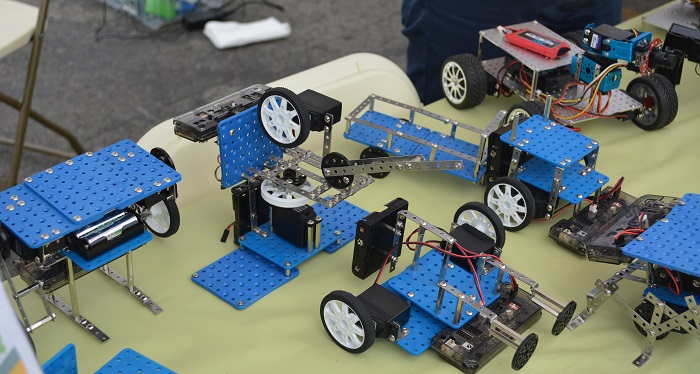 Here are some of the models which constructors can make from the Robolink kit.
Here are some of the models which constructors can make from the Robolink kit.
One of the new Robolink kit’s best accolades–besides the stream of interested visitors–was completely impromptu. A small boy, about seven years old, had been avidly watching the robot display. He began to wail as his father told him it was time to leave the tent! (Look for him to come back to OC Mini Maker Faire in about ten years, give or take, with a robotics display of his own!)
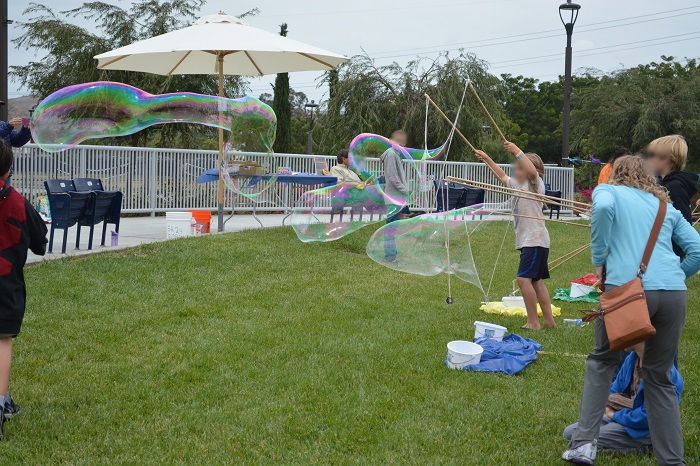
At the OC Mini Maker Faire, even the most basic element of fun was in for a reimagining.
“You open it, and then you close it,” a staffer explained, when asked how these visitors came up with such gigantic soap bubbles!
Live musical performances, throughout the day, added to the festive atmosphere. Bones of Contention started things off with a great set on the Chiptunes Terrace stage.
“I love it!” said Melinda Murray, Office Manager of Urban Workshop, when asked how she liked her organization’s new “create space”. Urban Workshop has now move to an 18,500-square-foot location! They’re hosting a free barbecue and Open House next weekend, to celebrate their grand re-opening; details are available on their Facebook page.
And if you think these guys look like they’re having fun, you really should have heard their music. David Sanchez, Stephon X. Jones and Joshua Green are three artists who do Chiptune in Riverside shows and events in the Inland Empire area…
…deejaying music they’ve created from vintage gaming components! And they sounded both fantastic and danceable.
Congratulations to all the talented and imaginative OC Mini Maker Faire exhibitors! Can’t wait to see what they’ll come up with, next year.

